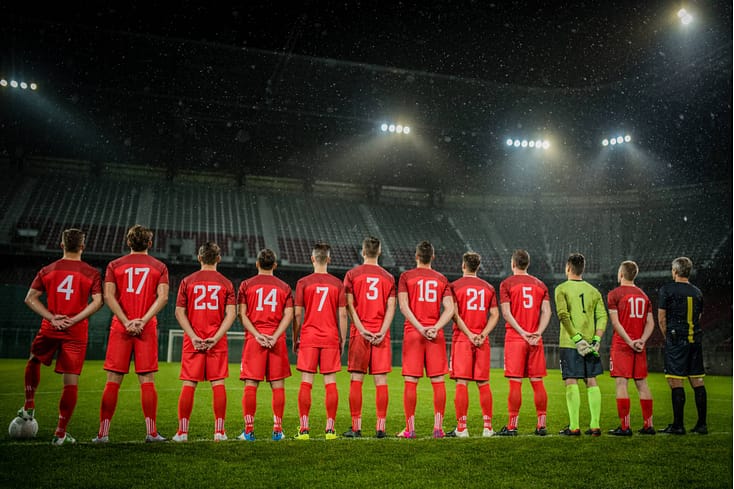Are you a die-hard football fan who can’t get enough of the game’s electrifying moments, strategic plays, and the sheer number of athletes working together to secure victory? If so, you’re in the right place! Today, we’re unraveling one of the most frequently asked questions among sports enthusiasts: how many football players are on a team? Whether you’re new to the sport or a seasoned follower, this deep dive will satisfy your curiosity and amplify your love for the game. So, grab your favorite jersey and let’s huddle up!
Understanding the Basics: Team Composition in Football
Football, especially American football, is a game of strategy, coordination, and teamwork. But just how many players make up a football team? The answer isn’t as straightforward as you might think because it varies depending on the level of play—be it high school, college, or the professional leagues like the NFL.
The NFL: The Professional Arena
In the National Football League (NFL), each team has a roster limit of 53 players during the regular season. However, only 46 players are active for each game. This setup ensures that teams have a mix of offensive, defensive, and special teams players ready to step onto the field at any moment.
Key Positions in the NFL:
- Offense: 22 players
- Defense: 22 players
- Special Teams: 9 players
| Category | Number of Players |
|---|---|
| Offense | 22 |
| Defense | 22 |
| Special Teams | 9 |
| Total | 53 |
College Football: A Slight Variation
College football teams, governed by the NCAA, typically have larger rosters. A standard college football team can have up to 120 players, providing a broader pool of talent and more specialized positions.
Differences from the NFL:
- Larger rosters allow for more specialized roles.
- Teams may have additional players for practice squads and developmental purposes.
| Category | Number of Players |
|---|---|
| Offense | 40 |
| Defense | 40 |
| Special Teams | 10 |
| Total | 120 |
High School Football: Building the Future Stars
High school football teams usually have smaller rosters compared to their college and professional counterparts. Typically, a high school team has around 40-70 players, depending on the size of the school and the level of competition.
Why Smaller Rosters?
- Limited resources and facilities.
- Emphasis on versatility, with players often taking on multiple roles.
| Category | Number of Players |
|---|---|
| Offense | 20 |
| Defense | 20 |
| Special Teams | 5-10 |
| Total | 40-70 |
Breaking Down the Positions: Who’s Who on the Field?
Understanding how many players are on a football team also involves knowing the different positions and their roles. Let’s take a closer look at the key positions that make up the offense, defense, and special teams.
Offense: The Strategists
The offensive unit is responsible for advancing the ball down the field to score points. Here’s a quick rundown of the primary offensive positions:
- Quarterback (QB): The leader of the offense, responsible for passing and handing off the ball.
- Running Backs (RB): Tasked with running with the ball and catching passes.
- Wide Receivers (WR): Specialize in catching passes from the quarterback.
- Tight Ends (TE): Serve dual roles as blockers and pass-catchers.
- Offensive Linemen (OL): Protect the quarterback and create paths for runners.
Defense: The Guardians
The defensive unit aims to stop the opposing offense from scoring. Key defensive positions include:
- Defensive Linemen (DL): Focus on stopping the run and pressuring the quarterback.
- Linebackers (LB): Versatile players who defend against both the run and the pass.
- Defensive Backs (DB): Cover receivers and defend against pass plays.
Special Teams: The Specialists
Special teams come into play during kicking plays and have specialized roles:
- Kicker (K): Handles field goals and kickoffs.
- Punter (P): Punts the ball on fourth downs.
- Return Specialists: Return kicks and punts.
- Long Snapper (LS): Specializes in snapping the ball for punts and field goals.
Roster Composition: Balancing the Team
Balancing the number of players across offense, defense, and special teams is crucial for a team’s success. Each side of the ball requires specialized skills, and having the right number of players ensures flexibility and depth.
Offensive Depth
An NFL offense typically consists of:
- 1 Quarterback
- 2 Running Backs
- 5 Wide Receivers
- 2 Tight Ends
- 5 Offensive Linemen
This composition allows for various formations and play strategies, keeping the defense guessing.
Defensive Depth
A standard NFL defense might include:
- 4 Defensive Linemen
- 3 Linebackers
- 4 Defensive Backs
This setup provides a balanced approach to defending against both the run and the pass.
Special Teams Composition
Special teams players are fewer but highly specialized:
- 1 Kicker
- 1 Punter
- 1 Long Snapper
- 2 Return Specialists
Their roles are critical during specific moments in the game, often swinging momentum in favor of the team.
The Evolution of Team Sizes: How the Game Has Changed
Football has evolved significantly over the years, and so has the size of the teams. From the early days of the sport to the modern era, changes in rules, play styles, and player specialization have influenced how many players are on a team.
Historical Perspective
In the early days, teams had smaller rosters, and players often played both offense and defense. This “ironman” approach required versatility but limited the specialization we see today.
Modern Specialization
Today, players focus on specific roles, allowing for greater specialization and strategic complexity. This shift has led to larger rosters, especially in college and professional football, where depth and specialized skills are paramount.
Balancing Act: Managing Roster Limits and Player Health
Maintaining the right number of players is not just about meeting roster limits but also ensuring player health and optimal performance throughout the grueling football season.
Injury Prevention and Management
Football is a physically demanding sport with a high risk of injuries. Teams must have enough players to replace injured athletes without overloading the roster.
Strategic Roster Moves
Coaches often make strategic decisions about which players to activate or deactivate based on performance, injuries, and the specific needs of each game. This dynamic approach keeps the team competitive and resilient.
Comparing Football to Other Sports: Team Sizes Matter!
Ever wondered how football team sizes stack up against other popular sports? Let’s take a quick glance:
| Sport | Number of Players on a Team |
|---|---|
| American Football | 53 (NFL) / 120 (College) |
| Soccer | 11 per side |
| Basketball | 12-15 (NBA) |
| Baseball | 25 (MLB) |
| Hockey | 20-23 (NHL) |
As you can see, football teams are significantly larger, reflecting the sport’s complexity and the diverse range of specialized positions required to succeed on the field.
The Role of Coaches and Support Staff
While we often focus on the players, it’s essential to recognize the critical role of coaches and support staff in managing the team’s size and composition.
Coaching Staff
A typical NFL team’s coaching staff includes:
- Head Coach
- Offensive Coordinator
- Defensive Coordinator
- Special Teams Coordinator
- Position Coaches
Each coach is responsible for specific aspects of the game, ensuring that players are well-prepared and strategies are effectively implemented.
Support Staff
Support staff includes trainers, medical personnel, analysts, and other specialists who help maintain player health and optimize performance. Their work behind the scenes is vital for a team’s success.
Fan Perspectives: Why Team Size Matters to You
As a passionate sports lover, understanding how many football players are on a team enhances your appreciation of the game. It highlights the teamwork, strategy, and depth required to compete at high levels.
Enhanced Viewing Experience
Knowing the roster size and player roles can make watching games more engaging. You’ll better understand the nuances of each play and appreciate the contributions of various team members.
Deeper Connection with the Team
Understanding the composition of your favorite team fosters a deeper connection, as you recognize the collective effort that drives success on the field.
Frequently Asked Questions (FAQs)
How many players are on an NFL team?
An NFL team has a roster limit of 53 players during the regular season, with 46 players active for each game.
Do football teams have different numbers of players at different levels?
Yes! College football teams can have up to 120 players, while high school teams typically range from 40-70 players.
Why are there so many players on a football team?
Football is a highly strategic and physically demanding sport that requires specialized roles for offense, defense, and special teams. Having a larger roster ensures depth, flexibility, and the ability to handle injuries.
How does team size affect game strategy?
Larger teams allow for more specialized roles and strategic diversity. Coaches can deploy various formations and tactics, making the game more dynamic and unpredictable.
Can a team have more players on the field at once?
No, regardless of the roster size, only 11 players from each team are on the field at any given time in football.
Wrapping It Up: Embrace the Complexity and Thrill of Football
So, how many football players are on a team? Whether it’s the 53-man rosters of the NFL, the expansive squads in college football, or the versatile athletes on high school teams, each number reflects the sport’s rich complexity and the collective effort required to triumph on the gridiron. As a sports lover, diving into these details not only deepens your understanding but also amplifies the excitement of every touchdown, tackle, and triumphant play.
Football is more than just a game; it’s a symphony of athletes working in harmony, each player contributing their unique skills to achieve a common goal. Next time you watch a game, take a moment to appreciate the intricate dance of players on the field, knowing that each one plays a vital role in the unfolding drama. Here’s to the love of the game and the incredible teams that make football the thrilling spectacle we all adore!


